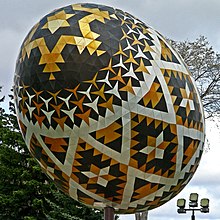

Ron Resch
| |
|---|---|

Vegreville egg
| |
| Born | Ronald Dale Resch 1939 |
| Died | November 24, 2009 (2009-11-25) (aged 70) |
Ron Resch (Ronald Dale Resch) was an artist, computer scientist, and applied geometrist, known for his work involving folding paper, origami tessellations and 3D polyhedrons.[1][2][3][4] [5][6][7]
Resch studied art at the University of Iowa receiving his Master of Fine Arts. Subsequently, he was a professor of architecture at the University of Illinois at Urbana-Champaign where he was affiliated with the Coordinated Science Laboratory. He went on to become a professor of computer science at the University of Utah.[8]
He famously designed the Vegreville egg, the first physical structure designed entirely with computer-aided geometric modeling software.
| Authority control databases: Academics |
|
|---|
This article about an artist from the United States is a stub. You can help Wikipedia by expanding it. |
| P ≟ NP | This biographical article relating to a computer scientist is a stub. You can help Wikipedia by expanding it. |